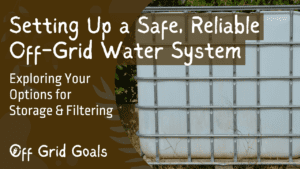Building a reliable water system is key for off-grid survival. Whether you’re collecting rainwater or hauling water, you’ve got to have storage and filtration setup.
Choosing Your Water Storage Tanks
Off-grid water storage can be setup with everything from traditional barrels to more modern cisterns. Here’s a few things to consider:
- Polyethylene Tanks: These versatile tanks are lightweight, durable, and come in various sizes, making them perfect for off-grid setups of all sizes.
- Steel Tanks: If durability is your priority, steel tanks are a solid choice. They can withstand harsh conditions and are ideal for long-term water storage.
- Fiberglass Tanks: Looking for something sturdy and corrosion-resistant? Fiberglass tanks fit the bill. They’re perfect for areas with extreme weather conditions.
How Much Water Do You Need to Store?
Be sure you take the time to crunch some numbers to figure out how much water you need to store. It’s going to be different for every situation depending on your water usage habits, climate, and local regulations. Start with this:
- Daily Water Usage: Estimate how much water your household consumes per day. This includes drinking, cooking, cleaning, and any other activities requiring water.
- Duration: Decide how long you want your water supply to last in case of emergencies or interruptions. A week’s worth of water storage per person is a good starting point.
- Multiply and Plan: Multiply your daily water usage by the number of days you want to store water. This gives you the total amount of water needed for storage. Don’t forget to account for any guests or future changes in household size, animal needs, and gardening.
Filtering Your Water: Keeping It Clean
Once you know how much water you need to store and what type of tanks you’ll store it in, the next step is to plan how you’ll keep your water clean and safe. Consider options like:
- Charcoal Filters: Simple yet effective, charcoal filters can remove impurities and improve taste.
- UV Purification: UV light systems can kill bacteria and pathogens, making water safe for consumption.
- Reverse Osmosis: For comprehensive purification, consider a reverse osmosis system that removes contaminants at a molecular level.
For our own water storage system, we’re implementing multiple filtering methods including this setup:

I’ve also used Berkey filter for our drinking water before, but they’ve been impossible to purchase with the issues they’ve been having with their black filters fight with the EPA. So we got this one for now:

A Few More Things to Think About
As you’re setting up your off-grid water systems, consider:
- Rainwater Harvesting: Maximize your water supply by harvesting rainwater. Install a system to collect rainwater from your roof and store it for later use.
- Conservation Practices: Every drop counts when you’re off the grid. Implement water-saving practices such as fixing leaks, using low-flow fixtures, and practicing mindful water usage.
- Emergency Preparedness: Prepare for the unexpected by keeping a reserve of bottled water and investing in a portable water filtration device for emergencies.
With careful planning and the right equipment, you can create a safe and reliable off-grid water system that meets your needs and ensures sustainability.



















